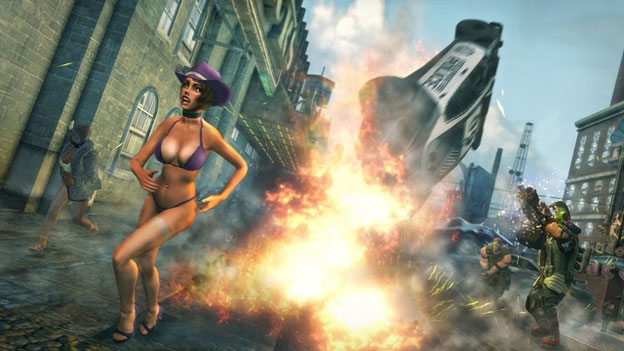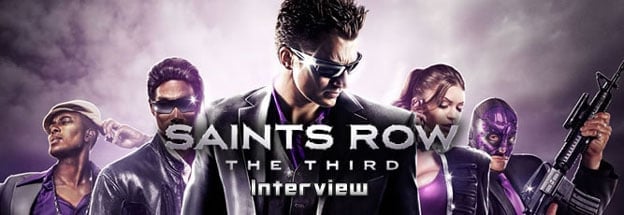Saints Row The Third Interview With Steve Jaros
Here at Cheat Code Central, we’re very excited about Saints Row: The Third. There’s just a certain something about unchecked, sandbox mayhem with an ever-escalating sense of scale that speaks to us. The game is coming out Tuesday and we’re bringing you an interview with the game’s lead writer, Steve Jaros, with whom we spoke back at the Saints Row: The Third preview event in Hollywood just last month.
Cheat Code Central: The first thing and most basic, you were the lead writer so I really wanted to know a little bit about the narrative; first of all, what’s the inspiration? Where did that come from?
Steve Jaros: Saints Row… drew a lot of influence from stuff like Kill Bill and Shoot ‘Em Up . Sort of worlds where there’s lots of crazy sh** happening, but everyone takes it really seriously, right? Like, even though the world around them is nuts, the characters themselves totally accept it as being reality, you know? No one questions in Kill Bill that there’s katana holders on the airplane; it’s just “of course they do, why wouldn’t you have katanas on an airplane?” And I think that that sort of thing was really important. I think that, structurally, the way that it’s written, I attribute a lot of it to stuff like The West Wing and Gilmore Girls , actually. Those are shows that are ensemble cast, that have very fast-written dialogue, lots of back-and-forth and quick interchanges. I think that that’s really important.
CCC: Going on from that, like you said, the universe is kind of insane, and these people do take it very seriously. How do you capture that? You have, I’m assuming, a team. You’re not the only person writing for this game, right?
SJ: No, I do have a team of writers.

CCC: So how do you maintain a consistent voice?
SJ: That’s hard, because there’s different people. I try to go and edit and go over things as much as I can, make sure it’s consistent. And sometimes it works and sometimes it doesn’t. The important stuff, I think, is to try to create enough of a baseline so that when you give to your team… Like, I wrote all the cutscenes, so those are all consistent. Now, for the mission stuff, I wrote a lot of rough drafts on a lot of them and then… on the mission lines I would do a pass over—all of the NPCs that you interact with? I did a pass on all their lines—then I did a pass on all the player lines, to be like, “Okay, this is how I want the player to interact and respond to all the mission lines in the game.” And then my team went and would write on the stuff for some of the alternate player voices. Be like, “Okay, this is kind of the guideline of what vein I want them to go and be like.” And then, when they would do their versions of it, they could play with them within those boundaries.
CCC: That’s a lot of dialogue to go over.
SJ: Yes.
CCC: Sounds like a tough job. Saints Row, then, since you have such direct control, is it kind of a personal labor of yours, or is this something that came together from an amalgam, a group of people’s ideas? Or was it something where a marketing exec said, “Hey, there’s a market for these open world gangster games”?
SJ: I’m actually the only designer on Saints Row: The Third that worked on all three games. And that was really exciting to go in being with the franchise for that long and see kind of how it’s evolved. But it’s totally a team effort… It’s a hundred percent team driven, and the guys that I work with are just super smart and super collaborative. I reviewed all those lines, right? But Jeff did the first pass, and then I could kind of go in and massage it to where I wanted it to be. It’s a huge team effort.
I do feel very close to the franchise, I do feel like it’s a bit of a labor of love for me. I think I’m just a little closer than it to other people. There’s a handful of us who’ve worked on all three games on the project and sometimes somebody’s like “Oh, sh**, seven years of our life have been spent on Saints Row.” By the same token, seven years of your life… That’s longer than I spent in high school… So that’s pretty intense.
CCC: So, shifting gears a little bit, in Saints Row, in what ways would you say narrative informs the gameplay and vice-versa?
SJ: We developed it together, and that was really important, because rather than me create the story and say, “Hey, make some missions around this story”… That’s a bad idea, because the story I come up with might make for a good movie or a book or a TV show or whatever, but that doesn’t mean it’s going to be a good game. Conversely, if a designer says, “Here’s a list of 20 missions, go and write a story for it,” that might not make for the best story, because I’m arbitrarily forced to shoehorn something in. So the way we did it was we developed it together. Scott and I went to a room and we hammered out the story and the mission flow at the same time, at a high level. We created that skeleton and then we went back and wrote a bunch of things out. But we wanted to make sure that at its core, at the spine of it, it held together at both a narrative level and in gameplay.
CCC: And that’s always been the case? That’s how it’s been since the first one?
SJ: Yeah, we definitely would go and try to make it all fit. One, two, and three were all developed that way.
CCC: In these games, you generally give players a lot of freedom in how they approach the game. Especially in this one where you’re kind of trying to tie together interlinked stories a little bit. Before, it’s been where you have a separate story for each gang and you complete them and then they all come together at the end. Now I’m hearing rumblings of multiple endings. How do you manage that? How did that kind of change your process? Because it sounds like now you’re giving the players more freedom and, at the same time, giving yourself a lot more work.

SJ: When people would complain about the story in Saints Row 1 and 2, one of the problems was, when you have a story that’s divided over three gangs at the same time, you have to be careful where you use a certain character. Shaundi only appears in the Sons of Samedi arc in Saints Row 2 because she gets kidnapped after mission four and I have to assume, “Well, what if they stop playing that mission after mission four and now they play a different Brotherhood one?” I can’t have Shaundi there because she’s been kidnapped, right?
But one of the reasons to make it a more linear set of missions in a row was to make it so that we could have the characters all go on a journey together and have the characters kind of evolve and have their own, more than an ensemble, arc. And then you use the city takeover component, have that be a little more freeform. “I wanna stop the Deckers! I’m gonna do all these little missions to go and stop the Deckers!” I think it was really important that we did that because otherwise we can’t be sure what events happened beforehand.
CCC: When you first created Saints Row, was it planned as a series of multiple installments or did it just kind of turn into a series?
SJ: No, it was always planned to be a series of multiple installments. What was interesting was, while it was always planned to be a trilogy, the sequel was not the one that was originally planned. And the sequel ended up being great, but it actually went in a different direction than we originally thought. Saints Row 2 had a different team than Saints Row 1 and they had their own kind of spin on where they wanted to take the franchise and do something different with the story than we had originally thought we were going to be able to do. So we had a plan, totally changed the plan, and then we went back and did what we did.
- Page 1
- Page 2
